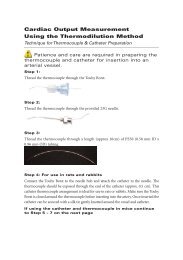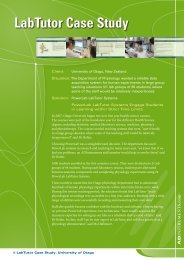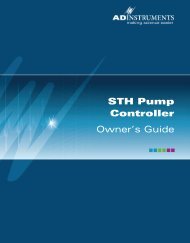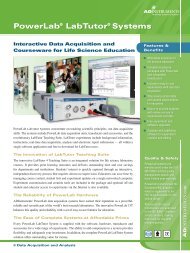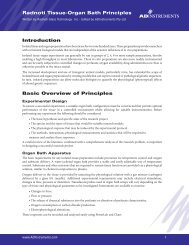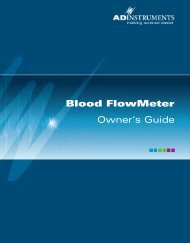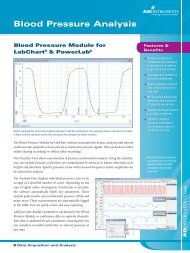Download - ADInstruments
Download - ADInstruments
Download - ADInstruments
You also want an ePaper? Increase the reach of your titles
YUMPU automatically turns print PDFs into web optimized ePapers that Google loves.
The average signal value is shown above the display area: the offset is<br />
displayed when the GP Amp is not zeroed, and may indicate a<br />
problem if it is large.<br />
You can stop the signal scrolling by clicking the Pause button at the<br />
bottom left (Macintosh) or top right (Windows) of the data display<br />
area. This changes to the Scroll button on the Macintosh. Click the<br />
Scroll button to start scrolling again.<br />
Shift and stretch the vertical Amplitude axis, by clicking and dragging<br />
it in various ways, to make the best use of the available display area.<br />
It functions the same as the Amplitude axis of the Chart Window,<br />
controls are identical and any change is applied to the Chart Window.<br />
Setting the Range<br />
The Range pop-up menu lets you select the input range or sensitivity<br />
of the channel. Changing the range in the GP Amp dialog is<br />
equivalent to changing it in the Chart or Scope window. The available<br />
ranges are the same as normal for LabChart and Scope.<br />
Filtering<br />
The High Pass and Low Pass pop-up menus provide signal filtering<br />
options appropriate to the type of transducers used with the GP Amp,<br />
and the measured signals, which tend to be of lower frequency.<br />
High-Pass Filtering. The two options in the High Pass pop-up menu<br />
are DC and 0.3 Hz. If DC is chosen, the GP Amp will be DC coupled,<br />
and pass both DC and AC signals. When 0.3 Hz is chosen, a high-pass<br />
filter before the first amplification stage removes any DC and<br />
frequency components lower than 0.3 Hz from the input. This option<br />
(AC coupling) is useful to remove a slowly changing signal<br />
component (when recording a fast signal superimposed on a slowly<br />
drifting baseline, for instance). It disables automatic zeroing.<br />
Low-Pass Filtering. The Low Pass pop-up menu gives a choice of off,<br />
1, 10 and 100 Hz low-pass filters. The filters remove high-frequency<br />
components from an input signal and help to eliminate components<br />
such as noise. There is also an Off setting, which allows frequencies of<br />
up to the GP Amp’s bandwidth of 5 kHz. (The highest frequency you<br />
can actually record is limited by the transducer you use: such<br />
information should be in the documentation supplied with it.)<br />
26<br />
GP Amp Owner’s Guide



